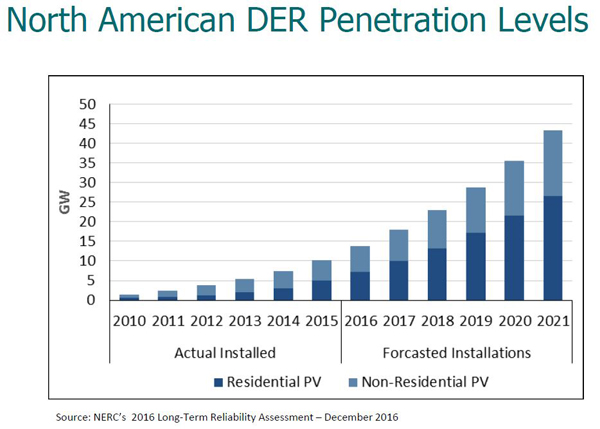Anticipating near term growth of Distributed Energy Resources (DERs), grid operators and power system experts across North America are increasingly prioritizing initiatives designed to more systematically co-ordinate distribution and transmission systems. This is a trend that may be establishing new operating models that will govern large parts of the electric system in the future.

NERC’s 2016 Long-Term Reliability Assessment (LTRA) identified conditions that appear to call for action. These include a rapid increase in forecasted levels of grid connected DERs. (See chart.)
NERC noted that “Data and information exchange across the transmission and distribution interface is a crucial aspect of power system planning, forecasting, and modeling.” It said that, “Both transmission and distribution entities should develop a common framework where this type of data exchange can be facilitated to ensure the reliability of the bulk system.”
NERC’s Distributed Energy Resources Task Force recommendations included the following:
• Develop a set of guidelines to assist in modeling and assessments, such that owners/operators of the bulk power system can account for the impact of DER
• Further evaluate data requirements and sharing of information across the transmission-distribution (T-D) interface to allow for adequate assessment of future DER deployments.
FERC Notice of Proposed Rulemaking (NOPR), issued November 17, 2016, is a potentially significant development for U.S. electricity markets. The IESO’s summary of the initiatives notes that it “raises the possibility of a formalized, mandatory framework for integrating storage and DERs into wholesale electricity markets.”
The ISO/RTO Council issued its Emerging Technologies Task Force Report in March 2017. Among other things it said, “In jurisdictions where Distribution System Operators (DSOs) exist, these entities should conform to a sufficiently rigorous set of standards that allows for the safe interaction between DSOs, non-utility actors and the bulk electricity system.”
In Ontario, the Grid/LDC Coordination Initiative has been established as a partnership between Alectra (then PowerStream) and the IESO in June 2016 to:
• Explore ways to enhance reliability and efficiency through coordination of IESO and LDC-controlled resources
• Establish a framework for data sharing between the IESO and all LDCs
• Explore the feasibility for increased adoption of residential solar storage type technologies within the LDC sector by using PowerStream’s POWER.HOUSE initiative, as a test case.
The Ontario Grid-LDC Interoperability Standing Committee has been established to lead this work in Ontario. Including representatives from LDC operations staff and sector partners, its objectives include:
• Establish a partnership to discuss issues and opportunities for a more coordinated operation of Ontario’s electricity system
• Increase awareness of upcoming changes at both the grid and distribution levels to understand the impact on system operations and identify practical ways to leverage these opportunities
• Identify existing capabilities that can be better leveraged to support efficient and reliable operation of Ontario’s electricity system.
